CHINA SCIENCE AND TECHNOLOGY
NEWSLETTER
The Ministry of Science and Technology
People's Republic of China
|
|
|
N0.635 |
October 30, 2011 |
|
|
|
|
|
|
|
|
IN THIS ISSUE
|
|
*WAN Met with American Guests
* WAN Met with Austrian Guests
*China-OECD Innovation Policy Roundtable
* MOST and Gates Signed MOU
*Nanobiology and Microsystem Cooperation
* Gene Regulating Grain Size Cloned
* DUV Technology into Cutting-Edge Instruments
|
|
INTERNATIONAL COOPERATION |
WAN Met with American Guests
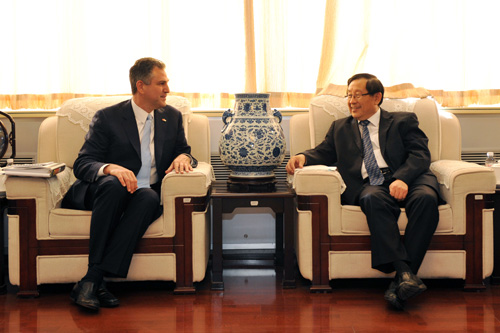
Chinese Minister of Science and Technology WAN Gang met with U.S. Deputy Secretary of Commerce Francisco Sanchez and his biomedical delegation on October 14, 2011 in Beijing. The two sides exchanged views on strengthening biomedical cooperation between the two countries. WAN briefed the other side of China-US science and technology cooperation and China’s science and technology development planning for the 12th five-year period (2011-2015) at the request of his guests. WAN encourages joint research and industrial cooperation between the two countries, saying that such cooperation would benefit both countries and peoples of the world. Sanchez said the U.S. is willing to continue the innovation cooperation under the China-US Joint Science and Technology Commission and Innovation Dialogues, rendering contributions to a better bilateral relationship and more economic and trade exchanges.
WAN Met with Austrian Guests
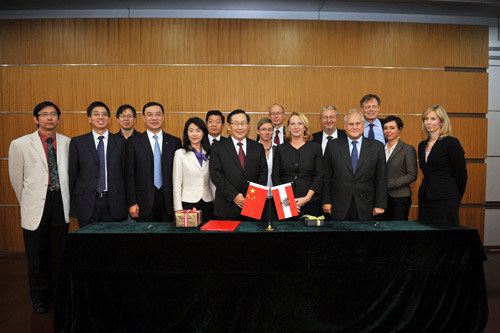
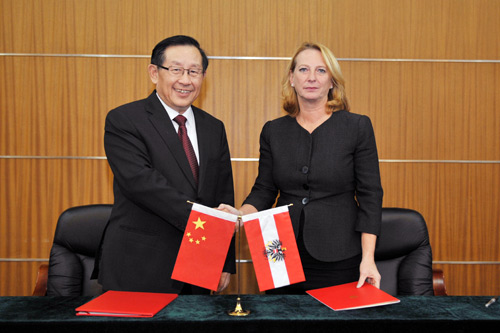
October 24, 2011—Chinese Minister of Science and Technology WAN Gang met with visiting Austrian Federal Minister of Transport, Innovation and Technology Ms Doris BURES, Austrian Ambassador to China Martin Sajdik and their party. The two sides exchanged in-depth views on establishing a cooperation mechanism between the two ministries, strengthening S&T cooperation between the two countries, especially in the areas of sustainable energy and environmental technologies.
WAN briefed the other side of China's science and technology development planning for the 12th five-year period, and welcomes the Austrian side to work with Chinese industry, universities, and research institutes. Madam BURES said Austria is willing to work on S&T innovation and cooperation under the framework of inter-governmental scientific and technological cooperation, in a bid to contribute to an enhanced bilateral relation and technical cooperation. After the meeting, two ministers jointly inked a summary report of the meeting.
China-OECD Innovation Policy Roundtable
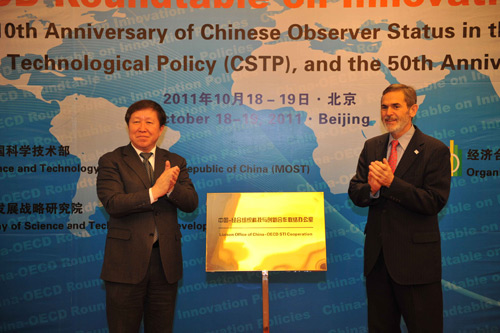
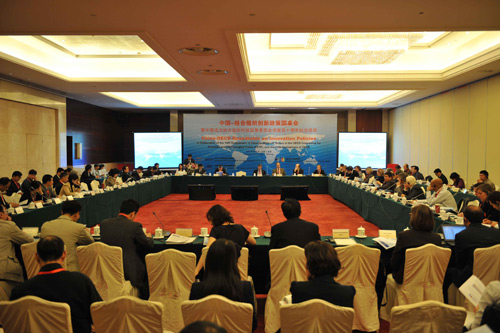
A China-OECD innovation policy roundtable meeting was held October 18-19, 2011 in Beijing. A 10th anniversary ceremony was also staged on the same day for China being an observer to the OECD Science and Technology Policy Committee. Chinese Vice-Minister of Science and Technology CAO Jianlin, OECD Deputy Secretary General Richard BOUCHER, and OECD Committee on Science and Technology Policy (CSTP)Chairman Luis SANZ-MANENDEZ were present at and addressed the opening ceremony. Some 100 representatives from government agencies, research institutions, universities, the OECD Secretariat, CSTP, OECD members’ embassies in Beijing, and some developing countries, attended the meeting.
At the opening ceremony, CAO and BOUCHER jointly inaugurated the opening of China-OECD Science and Technology Innovation Cooperation Liaison Office and China-OECD innovation policy information network . Both the Liaison Office and the Information Network will be operated by the Institute of Strategic Research. Mr. Andrew WYCKOFF from OECD Technology and Industry Division and WANG Yuan, executive vice president of the Institute of Strategic Research jointly undersigned a letter of intent on the establishment of the website. At the opening ceremony, Mr. WYCKOFF released the OECD Science and Technology Industry Scoreboard for 2011, and analyzed China's accomplishments in the area and the challenges it has faced. At the meeting, the Chinese version of China's National Innovation System Report, jointly prepared by the OECD and Chinese experts, were released to the public.
At the meeting, Chinese and foreign specialists discussed the issues on national innovation system management, public research management, and demand-side innovation. A range of presentations were made at the meeting, including OECD countries’ practice and experience in improving the management of national innovation system; China’s S&T development strategy and policy; the evolution of science and technology management system and the establishment of Policy Advisory Committee to strengthen macro coordination of S&T activities in Korea; the changing Italian public research institutions and associated analysis; research modeling of the triangular relationship between the mission, operation and management of public research institutions; strengthening the international cooperation of public research institutions and openness innovation; the United States Bayh-Dole Act for supporting and encouraging private sectors to possess intellectual property rights; policies and measures taken to encourage renewable energy and energy efficiency to address climate change, the carbon pricing that is being prepared, and the efforts supporting small and medium businesses enterprises to be part of clean energy and health research programs in Australia; and China's strategic planning and policies for the development of emerging industries. At the meeting, some new issues were also raised, including the measurement of investment in intangible assets, the role of technological innovation in the economic development, and the contents and methods applied in innovation systems management, for future study.
MOST and Gates Signed MOU
Chinese Vice-Minister of Science and Technology (MOST) ZHANG Laiwu and the Bill & Melinda Gates Foundation Co-chair Bill Gates jointly inked on October 26 an MOU on strategic cooperation in Seattle. The two sides will collaborate in the areas of modern agriculture and global health cooperation, developing inexpensive high-quality crop and animal varieties, biological medicines, and vaccines. The products will find applications and diffusions in China and in other developing countries with scarce resources.
Under the MOU, MOST and the Gates Foundation will promote scientific and technological advancements in the related fields and associated findings transfer, through strategic cooperation mechanisms, including joint working committee and co-fund, based on the principle of mutual respect, complementarity, and reciprocity. Both sides will work together to address the financial and human resources needs for the collaboration, and improve the management of projects and the efficiency of technology development. Findings derived from the collaboration will be applied in the developing countries and regions, including China, South Asia, and Africa, in a bid to reduce global poverties and diseases, facilitating human development and common progress.
Nanobiology and Microsystem Cooperation
Two international cooperation accords were undersigned at an international seminar on nanobiotechnology and microsystems held on October 22, 2011 in Chongqing. One is an accord jointly inked by Chongqing Science and Technology Research Institute, German Fraunhofer Institute for Electronic Nano Systems, and Chongqing University to apply micro-systems in food testing. The other was jointly signed by Chongqing Science and Technology Research Institute, Georgia Southern University, and SynZyme Technologies to make nano-biotechnology part of the drug development efforts. According to the agreements signed, research institutes and universities from China, the United States, and Germany will work together to promote the research and commercial applications in the areas of nanobiotechnology and micro-systems.
The seminar was part of the event jointly organized by the Chinese Ministry of Science and Technology and Chongqing Municipal Government to invite renowned overseas R&D institutions to tour around Chongqing in 2011. Some 30 specialists from the United States, Canada, Japan, Singapore, Germany and Switzerland attended the meeting.
Gene Regulating Grain Size Cloned
A national innovation research team, led by ZHANG Qifa at Huazhong Agricultural University State Key Laboratory for Crops Genetic Improvement, has recently cloned a quantitative trait locus GS5 in rice that controls grain size by regulating grain width, filling, and weight. Further functional studies revealed that the gene enjoys a broad application perspective in molecular breeding of high yield species. The findings were published in October 23 online issue of Nature-Genetics.
Numerous studies indicate that of the two genetic materials with identical background, the material producing large grains enjoys a higher GS5 gene expression, compared with the one producing smaller grains, with the former being 8.7% wider and 7.0% heavier than the latter, in addition to the difference in grain size traits. Meanwhile, per plant yield produced by the material generating large grains is 7.4% higher than the one generating smaller grains.
Sequencing of the promoter region in 51 rice accessions from a wide geographic range identified three haplotypes that seem to be associated with grain width, namely GS5 large grains, GS5 medium, and GS5 small, corresponding exactly to the grain width traits, where GS5 small is a wild rice plant, and GS5 large the mutations derived from domestication and breeding processes. Further analysis showed that mutants are formed depending on the natural variation of promoter GS5, suggesting that natural variation in GS5 contributes to grain size diversity in rice and may be useful in improving yield in rice and, potentially, other crops as well.
DUV Technology into Cutting-Edge Instruments
It is learned from the Chinese Academy of Sciences on October 27, 2011 that the deep UV solid state laser sources equipment development project worth an investment of RMB 180 million has proceeded smoothly since its launch in 2008. The project has produced 8 cutting-edge instruments, including DUV laser photochemical reaction apparatus, DUV laser photoluminescence spectroscopy, spin and angle resolved DUV laser photoelectron spectroscopy, in-situ time and space resolved DUV laser tunneling spectroscopy, and flight time and energy analyzer based angle-resolved DUV laser photoelectron spectroscopy. In addition, a variable DUV photon energy photoelectron spectroscopy has been basically completed of its development, and entered the test process. Some of the instruments have found applications in cutting-edge scientific researches, demonstrating their laudable performance.
Apart from the eight major instruments, researchers also established a range of platforms to develop DUV nonlinear crystals and devices, DUV solid-state laser apparatus, and associated applications. Core components, such as DUV crystals and components, have been produced at a small scale, which laid groundwork for the follow-up development and associated commercial applications.
Full-fledged Deep Earth Exploration
According to China Central Television, China’s deep earth exploration program has proceeded in a full-fledged manner. As the largest geological exploration initiated in the country, the program has staged a deep drilling in the Luobusha area in Himalayas with an elevation of 4400m, and similar projects in six other places, including Laiyang in Shandong, and Tengchong in Yunnan. Scientists will take one out of the seven drilling sites to work on scientific drilling beyond 10,000 meters.
Meanwhile, deep seismic reflection profiling, another part of the deep exploration, has been staged in Ali, Tibet. The probe is made using underground explosions, in a bid to understand the underground structures dozen kilometers away from the surface through tracking the echo signals.
According to a briefing, scientific deep drilling and deep seismic reflection profiling are the two component parts of China’s deep Earth exploration program, where thousands of researchers are working on nine pilot projects, including magnetotelluric probe, all crust elements probe among others. The project will be completed before the end of 2012. Based on the deep exploration, Chinese scientists are planning to reveal the details of Earth crust through a "crust exploration project", in an attempt to provide more detailed deep Earth data and information to securing the resource supply, disaster prevention and reduction, and the development of earth sciences.
World's First AP1000 Nuclear Deaerator

Two nuclear deaerators, the first of their kind in the world developed by the Harbin Boiler Factory for Sanmen AP1000 Unit 1 nuclear generator, have successfully rolled off the production line and delivered to the user. Up to date, Sanmen Unit 1 nuclear generator has been equipped with all the deaerators needed, allowing workers to seal off the cap of the conventional island. Sanmen Unit 1 is the world's first AP1000 nuclear power project. Made up of two deaerators and one water tank, the deaerator system developed by Harbin Boiler is a major component in the conventional island. The deaerator is 20m long and 3m across, with a weight about 64 tons. The water tank that works for the deaerator is 43.5m long, 5.3m across, and weighs 250.4 tons.
Groundbreaking for China Spallation Neutron Source

China Spallation Neutron Source, the largest science infrastructure in the country to date, kicked off its construction on October 20, 2011 in Dongguan City, Guangdong Province. The project will jointly be built by Chinese Academy of Sciences and Guangdong Province. Physically located in the Dalang Township, Dongguan City, the RMB 1.67 billion worth project is expected to be completed by 2018.
Test Platform for World's Fastest EMUs
Not long ago, a rail traffic laboratory, jointly established by the Ministry of Railways and Southwest Jiaotong University, was officially put into operation. The lab is built to be a simulation platform to test the operation of the fastest EMUs in the world, allowing the simulated EMUs to run at a speed of 600 km per hour under the interference of different rail lines.
The lab will work to build the platforms for basic rail traffic experiments and digital simulation, mainly on the basic and applied studies of the wheel-rail high-speed trains at a speed of 350 km or above, heavy trains with a carrying capacity of 20,000 tons or more, novel urban rail transit, high-speed maglev transportation, and super high-speed rail transportation, striving to achieve the proprietary innovations of key technologies and core equipment.
According to a briefing, the laboratory will soon work on the vehicle performance of CRH380A and the reliability test of Bogie under 400,000 kilometers of operation at a speed of 300 kilometers per hour. Meanwhile, the simulation platform will be turned into a security monitoring center, to foresee and ensure the safe operation of each train under an individualized life-cycle management.
Comments or inquiries on editorial matters or Newsletter content should be directed to:
Department of International Cooperation, MOST 15B, Fuxing Road, Beijing 100862, PR China Tel: (8610)58881360 Fax: (8610) 58881364
http://www.most.gov.cn

